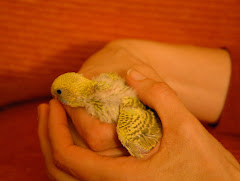nacly dog said...
this is acting as the flock leader. He checks out possibly tainted food, takes the first risk then guards the rest from possible predators. this behavior is consistent with dimporhism and a social hierarchy. I've seen flocks of geese show the same behavior. Sutcliffe would be a good leader for a small feral flock".
This is fascinating. I don't know much about geese, but remember their social structure being discussed in the book about King Arthur, "The Sword and the Stone" which I read as a young person. King Arthur spent time with many animals and learned their social behavior. The geese were very important to teaching King Arthur how to lead compassionately.
I am so proud of Sutcliffe! He came from a budgie bin, where he really had no upbringing or opportunity at all, and he has become tame, socialized, the pater familias who saved the life of his beloved child (Magoo), and a true flock leader.
Thanks naclydog for these insights!









